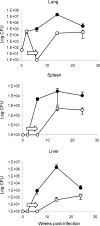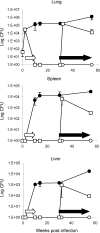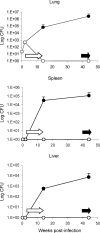Reactivation of latent tuberculosis by an inhibitor of inducible nitric oxide synthase in an aerosol murine model
- PMID: 12423311
- PMCID: PMC1782808
- DOI: 10.1046/j.1365-2567.2002.01511.x
Reactivation of latent tuberculosis by an inhibitor of inducible nitric oxide synthase in an aerosol murine model
Abstract
Exposure to Mycobacterium tuberculosis results in clinical tuberculosis only in a small percentage of healthy individuals. In most instances the bacilli are controlled by the immune system and survive in a latent state within granuloma. Immunosuppression, however, may result in reactivation of infection, resulting in clinical disease. Using a low-dose aerosol infection (30 colony-forming units) in mice, we describe a short-duration model for studying spontaneous and drug-induced reactivation of anti-tuberculous drug-treated, latent tuberculosis infection. Although a 4-week treatment with rifampicin and isoniazid reduced the number of bacilli to undetectable levels, the infection spontaneously reactivated following therapy. By contrast, an 8-week treatment period induced a state of latent infection, requiring immunosuppression to reactivate infection. Finally, a 12-week treatment period eliminated the bacilli completely and aminoguanidine did not induce reactivation of infection. In view of the fact that therapy in the selected protocol reduces the mycobacterial load to undetectable levels, the data suggest that an 8-week treatment period is necessary and sufficient to mount protective immunity in mice.
Figures







References
-
- Kochi A. The global tuberculosis situation and the new control strategy of the World Health Organization. Tubercle. 1991;72:1–6. - PubMed
-
- Stead WW. Pathogenesis of a first episode of chronic pulmonary tuberculosis in man: recrudescence of residuals of the primary infection or exogenous reinfection? Am Rev Resp Dis. 1967;95:729–45. - PubMed
-
- Raviglione MC, Snider DE, Kochi A. Global epidemiology of tuberculosis: morbidity and mortality of a global epidemic. JAMA. 1995;273:220–6. - PubMed
-
- Antonucci G, Girardi E, Raviglione MC, Ippolito G. Risk factors for tuberculosis in HIV-infected persons: a prospective cohort study. JAMA. 1995;274:143–8. - PubMed
Publication types
MeSH terms
Substances
Grants and funding
LinkOut - more resources
Full Text Sources
Other Literature Sources
Medical

